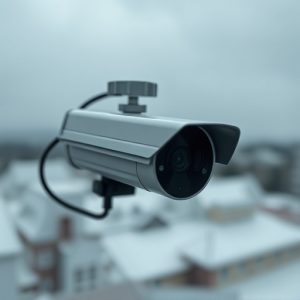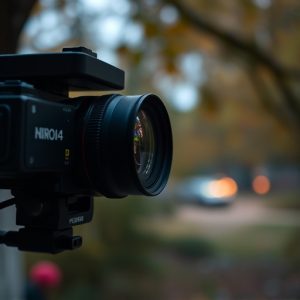Uncovering Hidden Cameras: Infrared Scanning for Home Security
The Invisible IR Camera has transformed home monitoring with its advanced infrared tech, capturing c…….
The Invisible IR Camera has transformed home monitoring with its advanced infrared tech, capturing clear images in low-light or darkness by detecting heat signatures. Popular for parental surveillance, property security, and professional uses, it operates discreetly, offers motion-activated recording, silent operation, and wireless data transmission. Its ability to locate hidden cameras enhances privacy protection, but raises legal and ethical concerns regarding consent and privacy rights. Effective deployment requires strategic placement, calibration, environmental protection, and encrypted storage for secure Invisible IR Camera Home Monitoring.
In the era of heightened security concerns, understanding hidden recording devices has become paramount. This article delves into the intricate world of invisible IR cameras used for home monitoring. We explore advanced scanning methods that employ infrared technology to uncover covert surveillance equipment. Balancing practical application with legal and ethical considerations, we provide best practices for implementing IR camera systems effectively while respecting privacy. By leveraging these techniques, homeowners can ensure a safer, more secure living environment.
- Understanding Hidden Recording Devices and Their Operation
- The Role of Infrared (IR) Technology in Uncovering Hidden Cameras
- Advanced Signal Scanning Techniques for Home Monitoring
- Legal Considerations and Ethical Implications of IR Camera Usage
- Best Practices for Safe and Effective Implementation of IR Camera Systems
Understanding Hidden Recording Devices and Their Operation
Hidden recording devices, often used for surveillance and home monitoring, have evolved significantly with advancements in technology. These devices are designed to operate discreetly, making them virtually invisible to the naked eye. One common type is the Invisible IR Camera, which utilizes infrared technology to capture video footage in low-light conditions or complete darkness. The camera’s ability to detect and process heat signatures allows it to record clear images, making it a valuable tool for home monitoring and security.
Their operation typically involves silent recording capabilities, where data is stored internally or transmitted wirelessly to a connected device. Many modern hidden cameras are equipped with motion sensors, ensuring they only activate when movement is detected, further enhancing their invisibility. This discreet nature makes them popular choices for parents monitoring children’s activities, individuals ensuring property security, and professionals in fields like law enforcement or private investigation.
The Role of Infrared (IR) Technology in Uncovering Hidden Cameras
Infrared (IR) technology has emerged as a powerful tool in the field of home monitoring and security, particularly when it comes to uncovering hidden recording devices. Invisible IR cameras are designed to detect heat signatures, making them capable of revealing devices that are not visible to the naked eye. This is especially useful in scenarios where regular visual inspections may not identify covert surveillance equipment.
IR scanning methods work by emitting infrared light and analyzing the reflected or emitted radiation. Unlike human eyes, these cameras can capture heat patterns, allowing them to detect components like lenses, sensors, and circuit boards that generate heat due to power consumption. This innovative approach ensures that homeowners and security professionals can identify hidden cameras, ensuring a deeper level of privacy protection in residential spaces.
Advanced Signal Scanning Techniques for Home Monitoring
In the realm of home monitoring, advanced signal scanning techniques have emerged as indispensable tools for detecting hidden recording devices. One of the most powerful innovations is the use of invisible IR (infrared) cameras, which can capture thermal energy emissions to reveal digital signals that are otherwise imperceptible to the human eye. These cameras operate in the dark, making them ideal for discreetly scanning spaces like offices, bedrooms, or conference rooms where hidden microphones or cameras might be installed.
By employing sophisticated signal processing algorithms and advanced image enhancement techniques, invisible IR cameras can detect subtle variations in temperature, translating these anomalies into visual representations of electronic signals. This enables security professionals and privacy advocates to uncover hidden recording devices, ensuring a safer and more secure home monitoring environment.
Legal Considerations and Ethical Implications of IR Camera Usage
The use of invisible IR cameras for home monitoring raises significant legal and ethical considerations. In many jurisdictions, the installation and operation of such devices are subject to strict privacy laws, which often require explicit consent from individuals whose images are being captured. Using hidden infrared cameras for surveillance can infringe upon personal privacy rights, as people have a reasonable expectation of privacy in their homes. Even if these cameras are designed to be invisible to the naked eye, their presence and activation can still constitute an invasion of privacy.
Ethically, the use of IR camera technology should balance security needs with respect for individual freedoms. Homeowners considering this method of monitoring must ensure they adhere to legal guidelines and ethical standards, such as clearly communicating the presence of surveillance devices to visitors and ensuring data collected is securely stored and accessed only by authorized personnel. Transparency and accountability are essential to maintaining trust in the use of invisible IR cameras for home monitoring.
Best Practices for Safe and Effective Implementation of IR Camera Systems
Implementing an invisible IR camera for home monitoring requires careful consideration and best practices to ensure both effectiveness and security. One key practice is to strategically place the cameras in well-lit areas, leveraging existing lighting or installing additional fixtures to minimize shadows that could obscure vital details. Additionally, employing motion-activated recording features ensures that the system captures only relevant data, enhancing privacy by reducing unnecessary recordings.
Regular maintenance is another crucial aspect. Calibrating the IR camera systems periodically ensures optimal performance and accurate readings. Protecting the devices from extreme environmental conditions, such as high temperatures or humidity, also prolongs their lifespan and maintains their sensitivity to infrared signals. Finally, using encrypted storage methods and secure network connections safeguards the recorded data, ensuring that only authorized individuals can access the invisible IR camera home monitoring system.
Hidden recording devices, often referred to as invisible IR cameras, pose unique challenges in home monitoring. However, advanced signal scanning techniques leveraging infrared technology offer powerful solutions. By understanding their operation and implementing best practices, individuals can ensure safe and effective use of these systems while navigating legal considerations and ethical implications. This comprehensive guide equips readers with the knowledge needed to harness the benefits of invisible IR cameras for enhanced home security.


